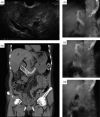Initial experience of endoscopic ultrasound-guided antegrade covered stent placement with long duodenal extension for malignant distal biliary obstruction (with video)
- PMID: 34118136
- PMCID: PMC9290461
- DOI: 10.1002/jhbp.1011
Initial experience of endoscopic ultrasound-guided antegrade covered stent placement with long duodenal extension for malignant distal biliary obstruction (with video)
Abstract
Background/purpose: This study aimed to evaluate the feasibility of endoscopic ultrasound (EUS)-guided antegrade covered stent placement with long duodenal extension (EASL) for malignant distal biliary obstruction (MDBO) with duodenal obstruction (DO) or surgically altered anatomy (SAA) after failed endoscopic retrograde cholangiopancreatography (ERCP).
Methods: Outcomes were technical and clinical success, reintervention rate, adverse events, stent patency, and overall survival. Inverse probability of treatment weighting (IPTW) and competing-risk analysis were performed to compare with conventional EUS-BD.
Results: Twenty-five patients (DO, n = 18; SAA, n = 7) were included. The technical and clinical success rates were 96% and 84%, respectively. Reintervention occurred in two patients (8.3%). Adverse events occurred in six patients (24%; two cholangitis, 16%; four mild postprocedural pancreatitis [24% (n = 4/17) in patients with non-pancreatic cancers]). The median patency was 9.4 months, and the overall survival was 2.73 months. After IPTW adjustment, the median patency in the EASL (n = 25) and conventional EUS-BD (n = 29) were 10.1 and 6.5 months, respectively (P = .018).
Conclusions: EASL has acceptable clinical outcomes with a low reintervention rate but higher rate of postprocedural pancreatitis in patients with non-pancreatic cancers. Randomized trials comparing EASL and conventional EUS-BD for MDBO with pancreatic cancers and DO/SAA after failed ERCP are needed to validate our findings.
Keywords: EUS-guided biliary drainage; Endoscopic ultrasound; duodenal obstruction; malignant biliary obstruction; surgically altered anatomy.
© 2021 The Authors. Journal of Hepato-Biliary-Pancreatic Sciences published by John Wiley & Sons Australia, Ltd on behalf of Japanese Society of Hepato-Biliary-Pancreatic Surgery.
Conflict of interest statement
All authors disclose no financial relationships relevant to this article.
Figures




References
-
- Dumonceau JM, Tringali A, Papanikolaou IS, Blero D, Mangiavillano B, Schmidt A, et al. Endoscopic biliary stenting: indications, choice of stents, and results: European Society of Gastrointestinal Endoscopy (ESGE) Clinical Guideline ‐ updated October 2017. Endoscopy. 2018;50:910–30. - PubMed
-
- Nennstiel S, Weber A, Frick G, Haller B, Meining A, Schmid RM, et al. Drainage‐related complications in percutaneous transhepatic biliary drainage: an analysis over 10 years. J Clin Gastroenterol. 2015;49:764–70. - PubMed
-
- Sharaiha RZ, Khan MA, Kamal F, Tyberg A, Tombazzi CR, Ali B, et al. Efficacy and safety of EUS‐guided biliary drainage in comparison with percutaneous biliary drainage when ERCP fails: a systematic review and meta‐analysis. Gastrointest Endosc. 2017;85:904–14. - PubMed
-
- Park DH, Jeong SU, Lee BU, Lee SS, Seo DW, Lee SK, et al. Prospective evaluation of a treatment algorithm with enhanced guidewire manipulation protocol for EUS‐guided biliary drainage after failed ERCP (with video). Gastrointest Endosc. 2013;78:91–101. - PubMed
-
- Misra SP, Dwivedi M. Reflux of duodenal contents and cholangitis in patients undergoing self‐expanding metal stent placement. Gastrointest Endosc. 2009;70:317–21. - PubMed
Publication types
MeSH terms
Grants and funding
LinkOut - more resources
Full Text Sources
Medical

